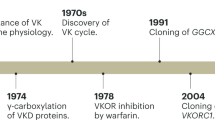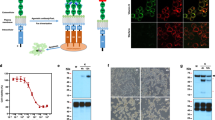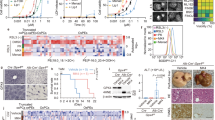Abstract
Vitamin K epoxide reductase (VKOR) catalyzes the reduction of vitamin K quinone and vitamin K 2,3-epoxide, a process essential to sustain γ-carboxylation of vitamin K–dependent proteins. VKOR is also a therapeutic target of warfarin, a treatment for thrombotic disorders. However, the structural and functional basis of vitamin K reduction and the antagonism of warfarin inhibition remain elusive. Here, we identified putative binding sites of both K vitamers and warfarin on human VKOR. The predicted warfarin-binding site was verified by shifted dose–response curves of specified mutated residues. We used CRISPR–Cas9-engineered HEK 293T cells to assess the vitamin K quinone and vitamin K 2,3-epoxide reductase activities of VKOR variants to characterize the vitamin K naphthoquinone head– and isoprenoid side chain–binding regions. Our results challenge the prevailing concept of noncompetitive warfarin inhibition because K vitamers and warfarin share binding sites on VKOR that include Phe55, a key residue binding either the substrate or inhibitor.
This is a preview of subscription content, access via your institution
Access options
Subscribe to this journal
Receive 12 print issues and online access
$189.00 per year
only $15.75 per issue
Buy this article
- Purchase on Springer Link
- Instant access to full article PDF
Prices may be subject to local taxes which are calculated during checkout






Similar content being viewed by others
Accession codes
References
Rost, S. et al. Mutations in VKORC1 cause warfarin resistance and multiple coagulation factor deficiency type 2. Nature 427, 537–541 (2004).
Li, T. et al. Identification of the gene for vitamin K epoxide reductase. Nature 427, 541–544 (2004).
Bell, R.G. & Matschiner, J.T. Vitamin K activity of phylloquinone oxide. Arch. Biochem. Biophys. 141, 473–476 (1970).
Berkner, K.L. & Runge, K.W. The physiology of vitamin K nutriture and vitamin K-dependent protein function in atherosclerosis. J. Thromb. Haemost. 2, 2118–2132 (2004).
Furie, B. & Furie, B.C. Molecular basis of vitamin K-dependent gamma-carboxylation. Blood 75, 1753–1762 (1990).
Sadowski, J.A., Esmon, C.T. & Suttie, J.W. Vitamin K-dependent carboxylase: requirements of the rat liver microsomal enzyme system. J. Biol. Chem. 251, 2770–2776 (1976).
Berkner, K.L. Vitamin K-dependent carboxylation. Vitam. Horm. 78, 131–156 (2008).
Bell, R.G. & Matschiner, J.T. Warfarin and the inhibition of vitamin K activity by an oxide metabolite. Nature 237, 32–33 (1972).
Shearer, M.J. & Newman, P. Recent trends in the metabolism and cell biology of vitamin K with special reference to vitamin K cycling and MK-4 biosynthesis. J. Lipid Res. 55, 345–362 (2014).
Shearer, M.J., Fu, X. & Booth, S.L. Vitamin K nutrition, metabolism, and requirements: current concepts and future research. Adv. Nutr. 3, 182–195 (2012).
Dam, H. & Schönheyder, F. A deficiency disease in chicks resembling scurvy. Biochem. J. 28, 1355–1359 (1934).
Link, K.P. The discovery of dicumarol and its sequels. Circulation 19, 97–107 (1959).
Chu, P.H., Huang, T.Y., Williams, J. & Stafford, D.W. Purified vitamin K epoxide reductase alone is sufficient for conversion of vitamin K epoxide to vitamin K and vitamin K to vitamin KH2. Proc. Natl. Acad. Sci. USA 103, 19308–19313 (2006).
Stenflo, J., Fernlund, P., Egan, W. & Roepstorff, P. Vitamin K dependent modifications of glutamic acid residues in prothrombin. Proc. Natl. Acad. Sci. USA 71, 2730–2733 (1974).
Sadowski, J.A. & Suttie, J.W. Mechanism of action of coumarins: significance of vitamin K epoxide. Biochemistry 13, 3696–3699 (1974).
Schulman, S. & Furie, B. How I treat poisoning with vitamin K antagonists. Blood 125, 438–442 (2015).
Fasco, M.J. & Principe, L.M. R- and S-Warfarin inhibition of vitamin K and vitamin K 2,3-epoxide reductase activities in the rat. J. Biol. Chem. 257, 4894–4901 (1982).
Fasco, M.J., Principe, L.M., Walsh, W.A. & Friedman, P.A. Warfarin inhibition of vitamin K 2,3-epoxide reductase in rat liver microsomes. Biochemistry 22, 5655–5660 (1983).
Hodroge, A., Longin-Sauvageon, C., Fourel, I., Benoit, E. & Lattard, V. Biochemical characterization of spontaneous mutants of rat VKORC1 involved in the resistance to antivitamin K anticoagulants. Arch. Biochem. Biophys. 515, 14–20 (2011).
Tie, J.K., Jin, D.Y., Tie, K. & Stafford, D.W. Evaluation of warfarin resistance using transcription activator-like effector nucleases-mediated vitamin K epoxide reductase knockout HEK293 cells. J. Thromb. Haemost. 11, 1556–1564 (2013).
Wallin, R. & Hutson, S. Vitamin K-dependent carboxylation: evidence that at least two microsomal dehydrogenases reduce vitamin K1 to support carboxylation. J. Biol. Chem. 257, 1583–1586 (1982).
Fasco, M.J., Hildebrandt, E.F. & Suttie, J.W. Evidence that warfarin anticoagulant action involves two distinct reductase activities. J. Biol. Chem. 257, 11210–11212 (1982).
Ernster, L., Ljunggren, M. & Danielson, L. Purification and some properties of a highly dicumarol-sensitive liver diaphorase. Biochem. Biophys. Res. Commun. 2, 88–92 (1960).
Wallin, R. & Suttie, J.W. Vitamin K-dependent carboxylation and vitamin K epoxidation: evidence that the warfarin-sensitive microsomal NAD(P)H dehydrogenase reduces vitamin K1 in these reactions. Biochem. J. 194, 983–988 (1981).
Wallin, R., Gebhardt, O. & Prydz, H. NAD(P)H dehydrogenase and its role in the vitamin K (2-methyl-3-phytyl-1,4-naphthaquinone)-dependent carboxylation reaction. Biochem. J. 169, 95–101 (1978).
Li, W. et al. Structure of a bacterial homologue of vitamin K epoxide reductase. Nature 463, 507–512 (2010).
Czogalla, K.J., Watzka, M. & Oldenburg, J. Structural modeling insights into human VKORC1 phenotypes. Nutrients 7, 6837–6851 (2015).
Rishavy, M.A., Usubalieva, A., Hallgren, K.W. & Berkner, K.L. Novel insight into the mechanism of the vitamin K oxidoreductase (VKOR): electron relay through Cys43 and Cys51 reduces VKOR to allow vitamin K reduction and facilitation of vitamin K-dependent protein carboxylation. J. Biol. Chem. 286, 7267–7278 (2011).
Schulman, S., Wang, B., Li, W. & Rapoport, T.A. Vitamin K epoxide reductase prefers ER membrane-anchored thioredoxin-like redox partners. Proc. Natl. Acad. Sci. USA 107, 15027–15032 (2010).
Liu, S., Cheng, W., Fowle Grider, R., Shen, G. & Li, W. Structures of an intramembrane vitamin K epoxide reductase homolog reveal control mechanisms for electron transfer. Nat. Commun. 5, 3110 (2014).
Czogalla, K.J. et al. Human VKORC1 mutations cause variable degrees of 4-hydroxycoumarin resistance and affect putative warfarin binding interfaces. Blood 122, 2743–2750 (2013).
Goodstadt, L. & Ponting, C.P. Vitamin K epoxide reductase: homology, active site and catalytic mechanism. Trends Biochem. Sci. 29, 289–292 (2004).
Bevans, C.G., Krettler, C., Reinhart, C., Watzka, M. & Oldenburg, J. Phylogeny of the Vitamin K 2,3-epoxide reductase (VKOR) family and evolutionary relationship to the disulfide bond formation protein B (DsbB) family. Nutrients 7, 6224–6249 (2015).
Rost, S. et al. Site-directed mutagenesis of coumarin-type anticoagulant-sensitive VKORC1: evidence that highly conserved amino acids define structural requirements for enzymatic activity and inhibition by warfarin. Thromb. Haemost. 94, 780–786 (2005).
Tie, J.K. & Stafford, D.W. Structural and functional insights into enzymes of the vitamin K cycle. J. Thromb. Haemost. 14, 236–247 (2016).
Fregin, A. et al. A new cell culture-based assay quantifies vitamin K 2,3-epoxide reductase complex subunit 1 function and reveals warfarin resistance phenotypes not shown by the dithiothreitol-driven VKOR assay. J. Thromb. Haemost. 11, 872–880 (2013).
Yang, X.-J. et al. Key amino acids of Arabidopsis VKOR in the activity of phylloquinone reduction and disulfide bond formation. Protein Pept. Lett. 22, 81–86 (2015).
Spohn, G. et al. VKORC1 deficiency in mice causes early postnatal lethality due to severe bleeding. Thromb. Haemost. 101, 1044–1050 (2009).
Caspers, M. et al. Two enzymes catalyze vitamin K 2,3-epoxide reductase activity in mouse: VKORC1 is highly expressed in exocrine tissues while VKORC1L1 is highly expressed in brain. Thromb. Res. 135, 977–983 (2015).
Hammed, A. et al. VKORC1L1, an enzyme rescuing the vitamin K 2,3-epoxide reductase activity in some extrahepatic tissues during anticoagulation therapy. J. Biol. Chem. 288, 28733–28742 (2013).
Ingram, B.O., Turbyfill, J.L., Bledsoe, P.J., Jaiswal, A.K. & Stafford, D.W. Assessment of the contribution of NAD(P)H-dependent quinone oxidoreductase 1 (NQO1) to the reduction of vitamin K in wild-type and NQO1-deficient mice. Biochem. J. 456, 47–54 (2013).
Thijssen, H.H. & Baars, L.G. Hepatic uptake and storage of warfarin. The relation with the target enzyme vitamin K 2,3-epoxide reductase. J. Pharmacol. Exp. Ther. 243, 1082–1088 (1987).
Hodroge, A. et al. VKORC1 mutations detected in patients resistant to vitamin K antagonists are not all associated with a resistant VKOR activity. J. Thromb. Haemost. 10, 2535–2543 (2012).
Matagrin, B. et al. New insights into the catalytic mechanism of vitamin K epoxide reductase (VKORC1) : the catalytic properties of the major mutations of rVKORC1 explain the biological cost associated to mutations. FEBS Open Bio 3, 144–150 (2013).
Haque, J.A., McDonald, M.G., Kulman, J.D. & Rettie, A.E. A cellular system for quantitation of vitamin K cycle activity: structure-activity effects on vitamin K antagonism by warfarin metabolites. Blood 123, 582–589 (2014).
Berg, J.M., Tymoczko, J.L. & Stryer, L. Biochemistry 5th edn. (W.H. Freeman, 2002).
Morrison, J.F. The slow-binding and slow, tight-binding inhibition of enzyme-catalysed reactions. Trends Biochem. Sci. 7, 102–105 (1982).
Stone, S.R. & Morrison, J.F. Mechanism of inhibition of dihydrofolate reductases from bacterial and vertebrate sources by various classes of folate analogues. Biochim. Biophys. Acta 869, 275–285 (1986).
Wallin, R. Vitamin K antagonism of coumarin anticoagulation: a dehydrogenase pathway in rat liver is responsible for the antagonistic effect. Biochem. J. 236, 685–693 (1986).
Watzka, M. et al. Thirteen novel VKORC1 mutations associated with oral anticoagulant resistance: insights into improved patient diagnosis and treatment. J. Thromb. Haemost. 9, 109–118 (2011).
Schmid-Burgk, J.L. et al. OutKnocker: a web tool for rapid and simple genotyping of designer nuclease edited cell lines. Genome Res. 24, 1719–1723 (2014).
Schmidt, T., Schmid-Burgk, J.L. & Hornung, V. Synthesis of an arrayed sgRNA library targeting the human genome. Sci. Rep. 5, 14987 (2015).
Tishler, M., Fieser, L.F. & Wendler, N.L. Hydro, oxido and other derivatives of vitamin K 1 and related compounds. J. Am. Chem. Soc. 62, 2866–2871 (1940).
Krieger, E. & Vriend, G. YASARA View: molecular graphics for all devices—from smartphones to workstations. Bioinformatics 30, 2981–2982 (2014).
Pettersen, E.F. et al. UCSF Chimera: a visualization system for exploratory research and analysis. J. Comput. Chem. 25, 1605–1612 (2004).
Krieger, E., Darden, T., Nabuurs, S.B., Finkelstein, A. & Vriend, G. Making optimal use of empirical energy functions: force-field parameterization in crystal space. Proteins 57, 678–683 (2004).
Morris, G.M. et al. Automated docking using a Lamarckian genetic algorithm and an empirical binding free energy function. J. Comput. Chem. 19, 1639–1662 (1998).
Acknowledgements
This work was supported in part by funding from BONFOR (grant 2015-1-01, K.J.C.), Baxter Germany, GmbH (J.O.) and the Deutsche Forschungsgemeinschaft (DFG) (grant Ol100 5-1, M.W. and J.O.). HEK 293T cells were obtained from E. Latz (Institute of Innate Immunity, University Hospitals Bonn; German Center for Neurodegenerative Diseases; and University of Massachusetts Medical School).
Author information
Authors and Affiliations
Contributions
Experimental design, K.J.C.; data collection, K.J.C. and K.L.; data analysis and figure production, K.J.C., K.L. and A.B.; protein modeling and in silico analysis, A.B.; CRISPR–Cas9 gene editing of HEK 293T cells, K.H., V.H. and K.J.C.; manuscript drafting and editing, K.J.C., A.B., K.H., V.H., K.L., M.W. and J.O.
Corresponding author
Ethics declarations
Competing interests
The authors declare no competing financial interests.
Integrated supplementary information
Supplementary Figure 1 Model I and model II of human VKOR.
(a) model-I in cyan with the loop and active site cysteines (yellow).
(b) model-II in blue with the loop and active site cysteines (yellow).
(c) Structural alignment between model-I (cyan) and model-II (blue) focused on the loop area.
Supplementary Figure 2 Docking of K1, K1>O and warfarin on hVKOR models I and II.
(a) illustrates the docking poses resulting from docking of K1 and K1>O on model-I (left and middle) and warfarin on model-II (right).
(b) illustrates the docking poses of K1 and K1>O on model-II (left and middle) and warfarin on model-I (left).
The model backbones are represented in grey ribbon format. The active site and loop cysteines are depicted in blue stick forms. K1, K1>O and warfarin are depicted in stick form with coloring according to the type of atom. The red colored transparent zone indicates location of the favourable docking poses chosen for analysis in this study based on the docking conducted as shown in (b).
Supplementary Figure 3 hVKOR-K1/K1>O residue interaction chart post equilibration (>20 ns).
(a) illustrates the simulation pattern for the K1>O bound structure.
(b) illustrates the simulation pattern for the K1 bound structure.
Both simulations reached equilibration around the 20 ns mark. Data points >20 ns are shown for every 10th simulation snapshot proceeding from 20 ns (i.e. 20 ns, 30 ns,…). The interacting residues for both simulations are similar. The K1 bound structure shows certain additional interacting residues at the end of the simulation (indicated by arrows in (b))
Supplementary Figure 4 Genotypes of VKORC1 and VKORC1L1 single- and double-KO cell lines.
Blue letters highlight target crRNA sequence in the reference sequence, deletions are indicated as dashes, insertions are depicted as extra letters below the sequence.
Supplementary Figure 5 Characterization of vitamin K reductases and NQO1 in VKORC1;VKORC1L1 double-KO cells.
(a) Absolute FIX activities of VKORC1/VKORC1L1 double KO cells transfected with F9 cDNA only (black bars), or F9 together with VKORC1 cDNA (white bars), F9 with VKORC1L1 cDNA (dark grey bars), F9 with NQO1 cDNA (light grey bars). Cells were cultured with different substrates as indicated at the x-achsis (10 μM K1, K1>O, K2, or K2>O).
(b) Absolute FIX activities of VKORC1/VKORC1L1 double KO cells transfected with F9 cDNA. All cells were cultured with 50 μM K1 and different concentrations of warfarin (0 μM, 1 μM, 10 μM) or dicoumarol (0 μM, 1 μM, 10 μM).
Supplementary Figure 6 Different conformational variations of the Phe55 residue and the ER luminal loop.
Changes within the hydrophobic pocket and the ER luminal loop of hVKOR (grey) at different stages with warfarin and K1>O bound and unbound with respect to the position of the critical residue Phe55 at the base of this pocket. The loop and the active site cysteines are shown in yellow colored stick forms.
(a) Model-I with Phe55 in green
(b) Model-I with warfarin bound (magenta) and Phe55 in red
(c) Model-II with Phe55 in purple
(d) Model-II with K1>O bound (blue) and Phe55 in cyan
(e) comparative view of the orientation of the critical Phe55 residue of all different states
Supplementary Figure 7 Docking of K>O on F55A and F55G variants.
The model backbones are depicted in ribbon format while the ligands are depicted in stick format. The illustration colors are based on secondary structure and atom type.
All depicted models represent simulation averaged equilibrated structures that have been subjected to a membrane embedded simulation run of 150 ns each.
(a) This shows the docking poses for K>O on Ph55Ala variant of the closed loop model-II.
(b) This shows the docking poses for K>O on Ph55Gly variant of the closed loop model-II.
Supplementary Figure 8 Spatial comparison of K1>O-binding residues on hVKOR with other similar complexes.
Comparative spatial location of K1>O binding residues on hVKOR with ubiquinone binding site residues on synVKOR and K1 binding residues on AtVKOR. The residues which are predicted/ known to bind the respective substrate (Yang et al, 2015 and Li et al, 2010) are shown in stick form.
(a) structural alignment of hVKOR model-II (yellow) with a model of the atVKOR (red) [downloaded from Swiss model database (http://swissmodel.expasy.org/repository/; accessed on 29th April 2016)], both in ribbon format.
(b) structural alignment of hVKOR model-II (yellow) with the crystal structure of synVKOR (blue) (PDB ID: 3KP9), both in ribbon format.
Supplementary information
Supplementary Text and Figures
Supplementary Figures 1–8 and Supplementary Tables 1 and 2 (PDF 1453 kb)
Model I structure
The PDB co-ordinates for the VKOR “open” form or Model-I (TXT 205 kb)
PDB file for model II
The PDB co-ordinates for the VKOR “closed” form or Model-II (TXT 205 kb)
Supplementary Data Set 3
Model 1 validation report (PDF 93 kb)
Supplementary Data Set 4
Model 2 validation report (PDF 95 kb)
Simulation of K1–VKOR complex
A video grab of the thermal motion of the K1 ligand within the K1-VKOR complex in a membrane embedded simulation (MOV 30355 kb)
Simulation of K>O–VKOR complex
A video grab of the thermal motion of the K>O ligand within the K>O -VKOR complex in a membrane embedded simulation (MOV 29585 kb)
Rights and permissions
About this article
Cite this article
Czogalla, K., Biswas, A., Höning, K. et al. Warfarin and vitamin K compete for binding to Phe55 in human VKOR. Nat Struct Mol Biol 24, 77–85 (2017). https://doi.org/10.1038/nsmb.3338
Received:
Accepted:
Published:
Issue Date:
DOI: https://doi.org/10.1038/nsmb.3338
This article is cited by
-
Drug-microbiota interactions: an emerging priority for precision medicine
Signal Transduction and Targeted Therapy (2023)
-
A novel graph mining approach to predict and evaluate food-drug interactions
Scientific Reports (2022)
-
Missense mutation of VKORC1 leads to medial arterial calcification in rats
Scientific Reports (2018)
-
Genetic variation in human drug-related genes
Genome Medicine (2017)
-
New pieces to an old puzzle: identifying the warfarin-binding site that prevents clotting
Nature Structural & Molecular Biology (2017)



